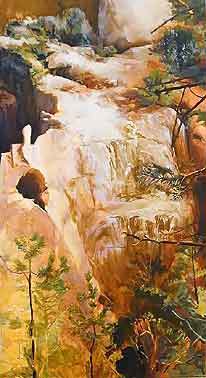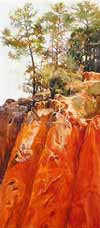
Untitled (Quarry II), 2001.
Oil on wood panel,
16 1/2" x 12 1/4".

Untitled (Quarry IV), 2001.
Oil on wood panel,
38" x 17".

Ancestor, 2001.
Oil on wood panel,
48" x 26".

The Ochre Quarry, 2001.
Oil on wood panel, 38" x 17".
American painting (art) is distinctive from European painting in a number of ways, as a national school, if you will, or if you want, but more as a matter of experience. Cézanne speaks for himself, or perhaps more than himself, when he talks of his little "sensations" before nature, but of course Impressionism in general might be described that way, the appearance of form in light which strikes not only the retina but the mind, and perhaps the soul. An American artist, like John Singleton Copley with his squirrel in Henry Pelham (Boy with a Squirrel), or Asher Durand with his trees, or Thomas Eakins with his bloody surgeon's hand in The Gross Clinic, or Arthur Dove with his blaring foghorn, or even Mark Rothko with his ethereal sunsets, focuses on a particular phenomenon, a detail that cannot be removed or escaped, that affects everything around it, that is everything around it, that begins everything, that pushes everything else out of the way or into a certain perspective. There is no way to avoid it, no Riviera or Bal Tabarin, no social justice or ideal universe. There is an unideal universe, say that of Pop Art, but no ideal one.
So it is particularly interesting when an American artist like Doug Martin goes to Europe and paints there. He is not drawn to something picturesque, or to a series of picturesque things, but rather to something obdurate and indigestible, a sandstone quarry in Provence, where he was teaching for a few months. There are trees and sky, but mostly there are the projecting cliffs and slopes of the quarry itself, where rainwater erodes the stone into a series of pools which then harden in the sun and are harvested to be used in pigments. As landscapes, the rock formations block the view; they are in the way. One is forced to look at them rather than beyond them, as though there were a secret here. And there is, which is that nothing exists without what is directly in view. This is the beginning of everything. The approach is both radically empirical, in the seemingly exclusive insistence on what is before us, and transcendental, with the grasping at forces that push both inwardly and outwardly. With very little indication of space or depth in the paintings, one senses enormous, continuous, and perhaps unending space and depth, and structure. There is no destination in these paintings, over a hill or along a path--no distant sea or moon or mountains. Distance is collapsed into not-distance, as, for instance, Pollock's "unconscious" imagery is subsumed by the energy of immediate movement and pattern.
It is immediately apparent what the paintings depict, and that remains at the center of consciousness, but within that depiction is something extremely complicated and contradictory. Looking at a rock face with its crevices, fissures, convolutions, and discolorations, geologically and meteorologically determined, it appears not only to record energy but to contain it, much as do the painter and his brush. They are consonant, artist and rock, in revealing depths, processes that are within, to the point that even the quarry's pigments have been used in the paintings. The canvases are all small and vertical, within the compass of the artist himself, and they cannot and will not extend beyond that compass, as though it were arrogant to do so, to extend beyond what the artist can see all at once.
Curiously, there is no depiction of detail in the paintings, yet it appears that everything is detail, that nothing is missing. Brushstrokes slash and swirl, smudge and drip, but never without being the trees, sky, clouds, rocks, bushes, and rivulets they describe. They reside in those forms and in the inter-relatedness of the mosaic represented. Certain colors dominate--yellow, red, orange--as one would expect in an ochre quarry, but their intensity as pure colors is still surprising. Why is that yellow so bright? Is it the white within it and around it? Is it possible that red can appear simply as red in nature, or that there can be an underlying tone of blue? The quarry itself is a pallette, basically of primary colors, from which the more subdued and complex colors--the browns and greens of trees--emerge. Ultimately, this is a place of earthly genesis, projecting its own logic, or pre-logic.
Donald Goddard © 2002